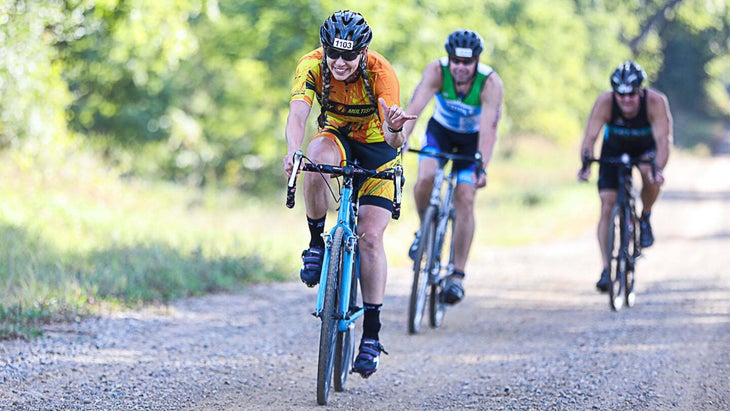New perk! Get after it with local recommendations just for you. Discover nearby events, routes out your door, and hidden gems when you sign up for the Local Running Drop.
Last week’s news that the Ironman World Championship would be taking on a new configuration – specifically, one that involves a race venue not on the Big Island – has left some triathletes feeling deflated. After all, when it comes to long days of training for an Ironman, qualifying for Kona can be a huge motivator. So what happens when that sentiment changes? Instead of throwing your hands up in despair and hanging up your tri bike for good (or rageposting on the internet), consider changing course with one of these 11 triathlon goals that don’t involve qualifying for Kona.
RELATED: 10 Questions with Ironman CEO on World Championships Split Announcement
1. Aim for a different championship event
Ironman isn’t the only championship race in town. There are plenty of opportunities for you to race your way to world-class competition in 2023, including the World Triathlon Championship Finals in Pontevedra, Spain and Challenge Family’s Championship race in Samorin, Slovakia. If you’d rather stay stateside, aim for the USA Triathlon Multisport National Championships in Irving, Texas or USA Triathlon Age-Group Nationals in Milwaukee, Wisconsin.

2. Set a short-course PR
Most iron-distance triathletes have forgotten just how hard short-course racing is. Don’t believe us? Race a sprint or Olympic-distance tri all out and tell us how you feel. Unlike the slow, measured trickle of discomfort in an Ironman triathlon, a short-course race takes all of that and puts it into one straight shot of pain. Can you still handle it? There’s only one way to find out.
RELATED: For our Members: 4 Printable Training Plans for Every Distance Tri
3. Podium at a local or regional tri
In addition to being much more affordable (and environmentally friendly) than flying to Kona, entering your local triathlon will help ensure these grassroots events are around for years to come, which is important if we want to keep growing the sport. But there’s one aspect of racing local triathlons that many forget about: Unlike larger triathlons with a global audience, local triathlons let you race on the same course, against many of the same athletes year to year. It’s an excellent way to see how you stack up against your peers—and see how much you’ve improved over time.
RELATED: From an RD: Only You Can Save Your Local Tri
4. Go long (really long)
Triathlon racing doesn’t stop at 140.6 miles. Whether you go for the American Triple-T Challenge (four races over three days), Ultraman (a three-day, 320-mile triathlon), or the Deca triathlon (ten Ironmans in ten days), there’s no denying that an ultra distance triathlon is an ultra test of endurance.
RELATED: Your Ultimate Guide to Ultra Triathlon
5. Give draft-legal a try
With World Triathlon’s recent decision to change the format of their Sprint World Championships to Draft Legal comes an increase in opportunities for age-group athletes to take part in the same style of racing as their favorite Olympians. But if you think drafting is “easy,” think again. Drafting on the bike, which is banned at most triathlon races (and especially in Ironman) is a skill that must be cultivated. It requires a head-on-a-swivel mentality, extremely quick reflexes, and most of all, excellent bike handling skills. If you get good enough at this style, you could even qualify for the 2023 Age-Group National Draft-Legal Championship race at the Multisport National Championships Festival in Irving, Texas.
RELATED: Draft-Legal Racing Matters, Not Just During the Olympics
6. Go the extreme route
Scandinavia’s Norseman Xtreme Triathlon has become widely regarded as the world’s toughest race —and also one of the most coveted, with thousands of athletes entering the lottery system for one of the 250 spots available each year. But if you aren’t one of those lucky lottery winners (we’re using “lucky” generously here, as winners are guaranteed to suffer during the cold, mountainous race), the XTRI race series offers plenty of extreme triathlons around the world: Starvation in Utah, Hispaman in Spain, and Celtman in Scotland are just a few of the uniquely masochistic adventures that await.

7. Do a du
All of the intensity, none of the pool time – if that sounds like your multisport dream, then duathlon is for you. The run-bike-run race format is just as competitive as its three-sport counterpart, with duathletes from all over the world racing for standing and points as they compete for the 2023 Multisport World Championship race in Ibiza, Spain.
RELATED: A Duathlon is the Perfect Way to (Not) Get Your Tri Toes Wet
8. Take your talents off-road
There’s no shortage of ways to take your skills off road. XTERRA racing allows you to rip up the mountain bike trails with the best of them. If you’re podium-worthy, you might just find yourself at the XTERRA Age-Group World Championships, which changes locations every year (last year, the finale was in Italy). If mountain biking isn’t your jam, try the rapidly-growing (and Jan Frodeno-approved) gravel tri format instead, where wide dirt paths are a bit more forgiving than rugged singletrack. (The best part? You won’t have to worry about sharing the road with cars.)
RELATED: How to Train for Gravel Triathlon

9. Set your sights on a single sport
Maybe you want to focus on your strongest discipline – or perhaps you want a reason to finally conquer your weakest link. Entering an open-water swim race, Masters track and field event, age-group crit race, or even a standalone marathon gives you the chance to flex your physical and mental multisport muscles in a different way. And if you do it, you’ll finally be able to answer the age-old question of which is harder: marathon training or Ironman training?
RELATED: Try These 11 Amazing Open Water Swim Races
10. Become a guide for athletes with disabilities
One of the biggest challenges for elite paratriathletes is finding a guide fast enough to race with them. If you’re already racing at the top of your class, consider using your time and talents to help another athlete get up there, too. Via trainings offered by organizations like Dare2Tri, Challenged Athletes Foundation, or the Special Olympics, you can learn the skills necessary to become a guide for athletes with visual impairments, mobility issues, or cognitive disabilities.
RELATED: How to Become a Guide for Athletes with Disabilities
11. Make it a team effort
Triathlon relay isn’t just a way to convince your coworker to dip their toes into the tri waters. With formats like Super League’s Enduro relay or USA Triathlon’s Mixed Relay National Championships, triathlon becomes a legitimate team sport, with tactics and strategies that add another layer to swim-bike-run. If you have some fast friends, it might be worth recruiting them to dominate the relay scene.
RELATED: Want to Get into Triathlon Mixed Relay? Here’s What You Need to Know
